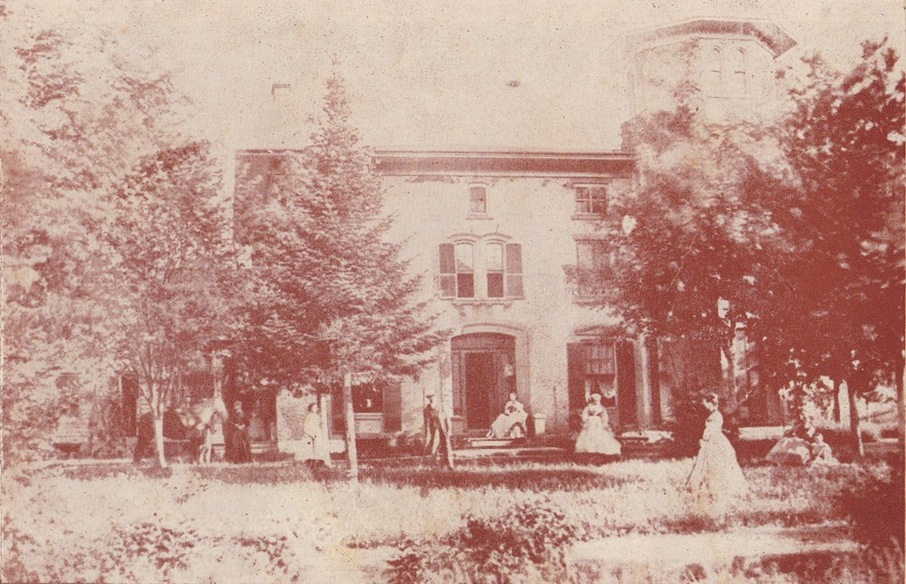Historic views of the Town Grove
wedding bells, 1917

The Charles Rudds inherited the house in 1914 and embarked on a massive renovation to bring the place up to date. Two years later Mrs. Rudd's sister was married there, in a small ceremony reported in the social column of the New York Times on December 28, 1917.
for whom the bell tolls
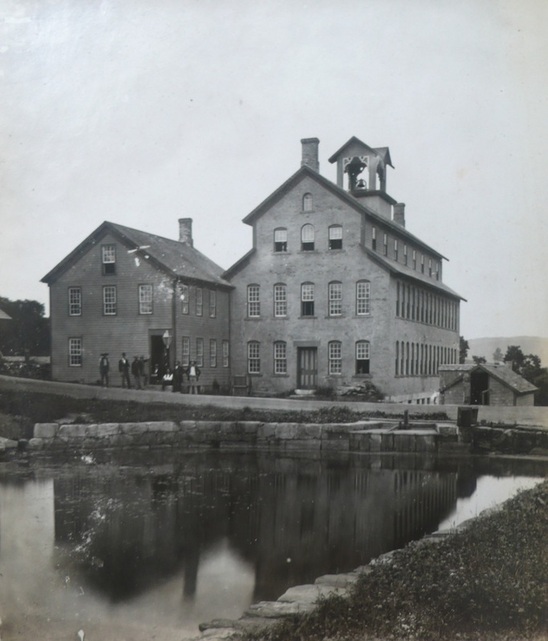
photo courtesy Holley descendant Charles Malcolm Henry Keil
The Holley Manufacturing Company Factory as viewed by an itinerant photographer on June 26, 1877, looking from Holleywood's yard, across the pond. A bell was installed in the cupola in 1867. It tolled at 7 AM for employees to start work, 6 PM for them to go home. Workers made $1 a day. Once, there was a strike against these conditions, according to Alexander Holley's Memorial Book which I had opportunity to read at The Salisbury Association.
On one occasion [the workmen] struck, “refusing to return except upon their own conditions and terms.” Holley locked the doors of factory building “leaving them to idleness, and giving them time to consider whether they were benefiting themselves or their families by these claims. After a few days reflection they sent one or two men as embassies, but Mr. Holley refused to receive them unless they came in the name of the whole body, to signify that they were ready to resume work. Soon they all expressed their willingness to return on the old footing, and so ended the first and only strike of the establishment.”
--from The Memorial of Alexander Hamilton Holley, Born August 12, 1804, Died October 2, 1887 printed by The Case, Lockwood & Brainard Company, 1888
On one occasion [the workmen] struck, “refusing to return except upon their own conditions and terms.” Holley locked the doors of factory building “leaving them to idleness, and giving them time to consider whether they were benefiting themselves or their families by these claims. After a few days reflection they sent one or two men as embassies, but Mr. Holley refused to receive them unless they came in the name of the whole body, to signify that they were ready to resume work. Soon they all expressed their willingness to return on the old footing, and so ended the first and only strike of the establishment.”
--from The Memorial of Alexander Hamilton Holley, Born August 12, 1804, Died October 2, 1887 printed by The Case, Lockwood & Brainard Company, 1888

The bell tolled the (later modified) work schedule of employees until the time of World War I, when the company ceased operations.
Today, the bell rests in a garden outside The Salisbury Bank in Lakeville, on a stone block that originally served as a base for an anvil used in forging the knife blades produced by the company.
Today, the bell rests in a garden outside The Salisbury Bank in Lakeville, on a stone block that originally served as a base for an anvil used in forging the knife blades produced by the company.
1840 - 1885: Italianate House Style
Italianate was the most popular house style in Victorian America. (It's also called "Tuscan".) The style began in England with the picturesque movement in the 1840s when builders began to design fanciful recreations of Italian Renaissance villas. Perhaps Alexander Holley discovered this style on an early foraging trip to Sheffield, England where he went to look for pocket knife designs and skilled craftsmen. By the late 1860s, Italianate was the most popular house style in the United States, and remained popular until the 1870s. When Alexander Holley built his Italianate house in 1853, he was ahead of his time.
Italianate houses have many of these features*:
*Sourced, embarrassingly, from About.com
Italianate houses have many of these features*:
- Low-pitched or flat roof
- Balanced, symmetrical rectangular shape
- Tall appearance, with 2, 3, or 4 stories
- Wide, overhanging eaves with brackets and cornices
- Square cupola
- Porch topped with balustraded balconies
- Tall, narrow, double-paned windows with hood moldings
- Side bay window
- Heavily molded double doors
- Roman or segmented arches above windows and doors
*Sourced, embarrassingly, from About.com
no free merch for family, apparently

image courtesy of The Salisbury Association
In addition to pocket knives, the Holley Manufacturing Company made small household goods. This is a bill of sale for two baking dishes sold to Governor Holley's third wife who was getting ready to host a family celebration for her husband's 83rd birthday on August 12, a few months before he passed away.
from the diaries of Alexander H. Holley

Image courtesy of The Salisbury Association, Inc.
We are unusually fortunate in that the original owner of this house kept a blog of sorts to chronicle the building of Holleywood. Thanks to Katherine Chilcoat and The Salisbury Association, I have a copy of excerpts from these diaries made by John Krom Rudd, his great-grandson (the seller's father) who took them from notes made by his father, Charles E. Rudd.
March 27, 1851
The men broke ground today for the new barn on Ion hill, first ground broken for the new place of residence. [Ion Hill was apparently Holleywood's original name.]
January 15, 1852
I went with seven teams to Egremont after stone for the underpinning of my house. We reached home with seven large loads of sawed stone of various sizes which cost me, including drawing, about $75. Some of this will do for window caps and sills.
March 16, 1852
Spent the forenoon in perfecting the plan of my house - a plan which I think I shall now build upon after having made 30 or 40 different ones.
May 19, 1852
Wrote Mr. Sloat, Superintendent of the Harlem Railroad, about freighting brown stone for my house, requesting a car and care. [Can you imagine calling Metro North to request a special car for your stone?]
September 7, 1852
Today I commenced coloring my house by mixing Ohio paint with the third coat of mortar made of gravel. [Gravelling your house--an odd but then-prevalent custom. Some say it was done to keep vines from growing into the brick.]
Alexander H. Holley moved into his new house on November 11, 1853 with his second wife Marcia Coffing Holley and their two children, John Coffing Holley (then 16) and Maria Coffing Holley (then 11). Marcia died on March 11, 1854, just four months to the day after they had moved in. He married his third (and last) wife, Sarah Coit Day, on November 11, 1856. His diary entry for November 15 notes "I introduced my wife to her new home, to which we all made her welcome and where I hope her future happiness will be augmented." Sarah lived there until her death in 1899.
March 27, 1851
The men broke ground today for the new barn on Ion hill, first ground broken for the new place of residence. [Ion Hill was apparently Holleywood's original name.]
January 15, 1852
I went with seven teams to Egremont after stone for the underpinning of my house. We reached home with seven large loads of sawed stone of various sizes which cost me, including drawing, about $75. Some of this will do for window caps and sills.
March 16, 1852
Spent the forenoon in perfecting the plan of my house - a plan which I think I shall now build upon after having made 30 or 40 different ones.
May 19, 1852
Wrote Mr. Sloat, Superintendent of the Harlem Railroad, about freighting brown stone for my house, requesting a car and care. [Can you imagine calling Metro North to request a special car for your stone?]
September 7, 1852
Today I commenced coloring my house by mixing Ohio paint with the third coat of mortar made of gravel. [Gravelling your house--an odd but then-prevalent custom. Some say it was done to keep vines from growing into the brick.]
Alexander H. Holley moved into his new house on November 11, 1853 with his second wife Marcia Coffing Holley and their two children, John Coffing Holley (then 16) and Maria Coffing Holley (then 11). Marcia died on March 11, 1854, just four months to the day after they had moved in. He married his third (and last) wife, Sarah Coit Day, on November 11, 1856. His diary entry for November 15 notes "I introduced my wife to her new home, to which we all made her welcome and where I hope her future happiness will be augmented." Sarah lived there until her death in 1899.
early drawing of Holleywood
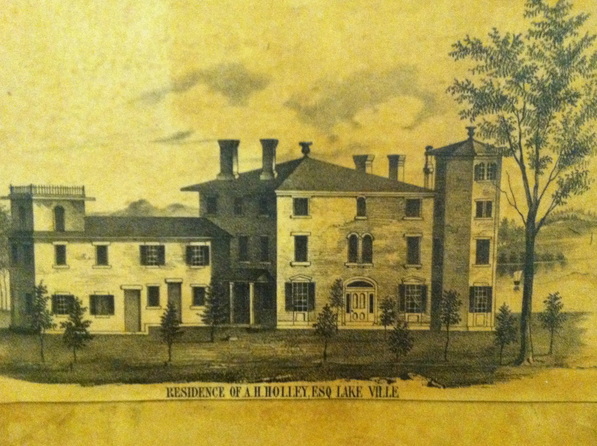
Image courtesy of The Salisbury Association, Inc.
We wonder how true was this representation which shows cupolas on roofs of the main house and the turret, widows walk on attic roof and chimneys that no longer exist. Note original front doors (which we found in the basement) and sidelights which we mean to replace.
UPDATE: Thanks to historical photos supplied by Holley descendant Charles Keil, we now know that the sidelights were figments of the artist's imagination.
UPDATE: Thanks to historical photos supplied by Holley descendant Charles Keil, we now know that the sidelights were figments of the artist's imagination.
Holley's home pre-Holleywood

photo and info from “Alexander Holley and the Makers of Steel” by Jeanne McHugh, John Hopkins University Press, 1980
When Alexander Hamilton Holley married his first wife Jane Lyman in 1831, he moved from his childhood home (the Holley-Williams house) into this Lakeville house which had just been enlarged by a second story and an attic. Here, a year later, his son Alexander Lyman Holley was born and his wife Jane died in childbirth.
Alexander Hamilton Holley remarried a few years later and continued to live here with his family for the next 22 years, until Holleywood was completed in 1853.
This photo, made from a glass plate negative, was taken on March 6, 1899 shortly before the house was demolished.
Alexander Hamilton Holley remarried a few years later and continued to live here with his family for the next 22 years, until Holleywood was completed in 1853.
This photo, made from a glass plate negative, was taken on March 6, 1899 shortly before the house was demolished.
the flood of 1955
In August 1955, hurricanes Connie and Diane swept through Connecticut and unleashed a devastating flood, the worst natural disaster in the state's recorded history. A tree fell on the Gatehouse, but miraculously, did no damage. "It was the middle of a hurricane," remembers Catherine (Cappy) Tastapaugh who grew up in the house. "Suddenly, we heard voices in the back yard screaming for us to get out. We ran to a neighbor's and from an upstairs window, watched the tree fall on our house. We'd been watching out for another tree, not the one that fell. We couldn't go out the front door until the State removed it."
in the good old summertime
Girls in white dresses, men in boaters, babies in their perambulators. This rare view of Holleywood with people on premise gives a glimpse of an era gone with the wind. Katherine Chilcoat (Town Historian) provided the image and hopes that owner of original print (or glass negative?) will come forward to identify date and identities. UPDATE: Thanks to Rudd family member Theodore O'Neill, the mystery has been solved. This is believed to be the earliest photographic view of Holleywood. It's an enlargement made in November, 1940 by Malcolm Day Rudd, made from a wet plate by Pease Bros, Lee, MA, June 1867. Info supplied by Maria C.H. Road in 1902 identifies left to right: William B. Rudd (partly behind Clare Coffing's horse), Clare Coffing in front of horse, Mrs. Fowler (housekeeper) on side porch, Maggie Orr (with mallet, standing by tree), James R. Harrison (with mallet), Mrs. Sarah C. Day Holley (on front porch), Nurse Annie and Little John C. Holley, Marcia C. H. Rudd (seated) with Alice Orr by her side, Laura Ward Holley, standing with her back to the driveway circle.
secret gardens
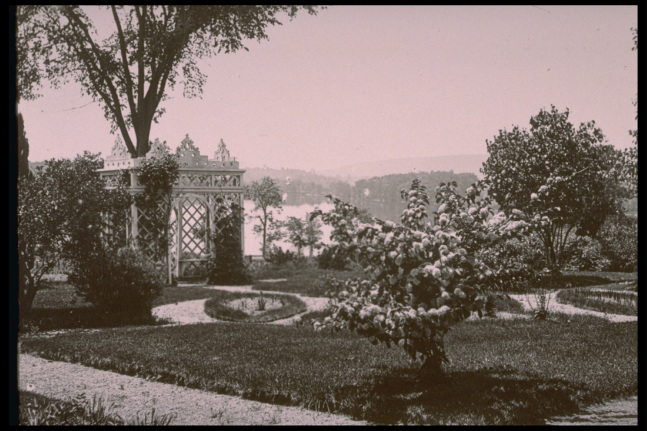
This was Holleywood's back yard in the 1860s, a site that is today dense with brush and overgrown trees blocking any view of the lake. Note how clever the garden design was. The plan was simple and plantings strategic, so that relatively little care was required to keep up what appears to be a formal garden. When we get to landscaping, we mean to emulate this.
The carved gazebo was a gift from the Governor to his wife in 1859. Unfortunately, it was bought in the Tag Sale.
Photos courtesy of The Salisbury Association, Inc.
The carved gazebo was a gift from the Governor to his wife in 1859. Unfortunately, it was bought in the Tag Sale.
Photos courtesy of The Salisbury Association, Inc.
19th century artist's rendering
Note the open lake views and step-down block at the entrance for guests arriving by carriage. Sadly, the side porch (also in photos below) did not survive.
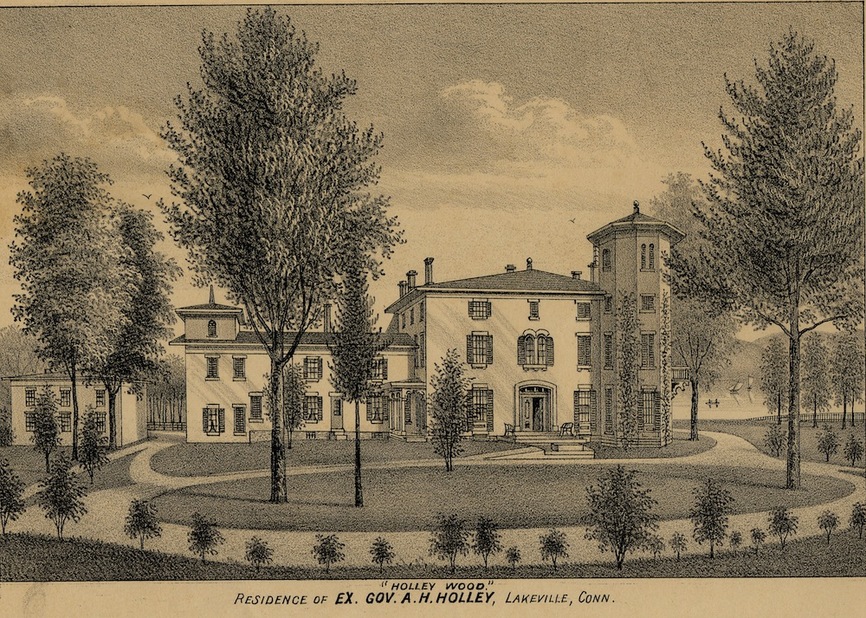
Image courtesy of The Salisbury Association, Inc.
the house came of age with photography

stereoscopic image of Governor Holley at Holleywood, courtesy of The Salisbury Association, Inc.
When Governor Holley built his house, stereo photography was the rage. A popular form of home entertainment was provided by the newly invented stereoscope which was a binocular viewer that made side-by-side images appear as one 3D image. (A century years later, it sparked a similar craze in my childhood: Viewmaster.)
This view of Holleywood was taken by King T. Sheldon, a "stereoscopic" photographer with a practice in West Winsted, CT. I found a few of his other images in the New York Public Library, and I gather that, to augment his studio business, he wandered around making images to sell to home owners and travellers. I imagine him coming upon Holleywood and prevailing upon Alexander H. to pose for this photo by the front door, stepping back so that his camera could take in the turret.
This view of Holleywood was taken by King T. Sheldon, a "stereoscopic" photographer with a practice in West Winsted, CT. I found a few of his other images in the New York Public Library, and I gather that, to augment his studio business, he wandered around making images to sell to home owners and travellers. I imagine him coming upon Holleywood and prevailing upon Alexander H. to pose for this photo by the front door, stepping back so that his camera could take in the turret.
the lake

One of the most romantic aspects of Holleywood (to me) is that it is set on the shores of idyllic Wononscopomuc Lake-- Lakeville Lake to locals. (Tale of how the lake got its name, here.)
Still barely visible along the banks at the edge of the property is a path that was once a railroad bed. In the late 1800's, trains steamed along the lake below Holleywood on their way from Hartford to Poughkeepsie, carrying not only coal and farm products, but city dwellers making their escape to the country. The Lake became a favorite location for fairs and huge picnics such as this one for the Masons in 1883 when 7500 came to celebrate the Montgomery Lodge's Centennial. (Lodge history here.)
photos and history from The Lake Wononscopomuc Association website
Still barely visible along the banks at the edge of the property is a path that was once a railroad bed. In the late 1800's, trains steamed along the lake below Holleywood on their way from Hartford to Poughkeepsie, carrying not only coal and farm products, but city dwellers making their escape to the country. The Lake became a favorite location for fairs and huge picnics such as this one for the Masons in 1883 when 7500 came to celebrate the Montgomery Lodge's Centennial. (Lodge history here.)
photos and history from The Lake Wononscopomuc Association website

The lakefront area just below Holleywood and across Factory Pond became known as Holley Grove, long a favorite location for picnics, boating and swimming. Since the 1800's, regattas have been held here and boat races well attended, as was this one photographed in 1910.
In the late 1940s, the Holley family rented space on the Grove to a concessionaire who sold foodstuffs, bait, tackle and other sundries. In 1951, the town purchased Holley Grove and maintains it today as a public park called Town Grove.
In the late 1940s, the Holley family rented space on the Grove to a concessionaire who sold foodstuffs, bait, tackle and other sundries. In 1951, the town purchased Holley Grove and maintains it today as a public park called Town Grove.
pocket knives

In 1844, Alexander Hamilton Holley (who would later build Holleywood) established a new industry at the lake. He built the Holley Manufacturing Company to make pocket knives and cutlery from the local ore. The factory became the largest employer in mid-19th century Lakeville and the building still stands in the historic district named for it: Pocket Knife Square.
The Holley line of handmade pocket knives was shown at the Centennial Exposition in Philadelphia in 1876. Alexander Holley died a year later and the business was taken over by his son Alexander Lyman Holley who ran it until his death in 1901, when directorship went to Malcolm Day Rudd, the seller's great-uncle. Eventually, mass production put the company out of business. The last directors' meeting was in 1946.
This Christmas catalog from 1904 sold on ebay recently for more than the cost of all of the knives listed: $518. More info and catalog illustrations here.
The Holley line of handmade pocket knives was shown at the Centennial Exposition in Philadelphia in 1876. Alexander Holley died a year later and the business was taken over by his son Alexander Lyman Holley who ran it until his death in 1901, when directorship went to Malcolm Day Rudd, the seller's great-uncle. Eventually, mass production put the company out of business. The last directors' meeting was in 1946.
This Christmas catalog from 1904 sold on ebay recently for more than the cost of all of the knives listed: $518. More info and catalog illustrations here.


